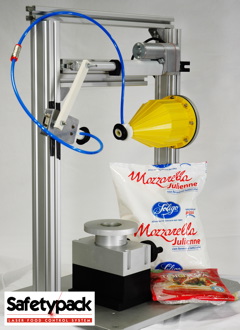EU Project to Develop Gas Sensor Technology
- Published: August 12, 2014
TAASTRUP, DENMARK | The Danish Technological Institute reports on a new European Union (EU) project designated Safetypack. This goal is to develop and validate gas sensor technologies that can measure the gas composition inside a sealed packaging without the products being taken out of the packing line and without spoiling the products. This means that the foodstuff industry can measure the gas composition in all of their production and thereby reduce waste and complaints as well as ensuring product quality and safety. 
Today many food products are gas packed in order to maintain quality and prolong shelf life of the products. The institute explains that after packing, the gas composition inside the packaging will rapidly change as a result of reaction with the product and microorganisms, as well as the fact that a packaging is never absolutely tight. This is why it is important to know the development of the gas composition. According to the institute, today it is not possible to measure the gas composition inside the packaging on all products in a production, but typically a few random tests are made during a production period.
Typical challenges in obtaining optimum gas packing are caused by the following:
• Replacement of all air in a packaging is a challenge, as the packing line is surrounded by atmospheric air.
• Dissolved air is hidden in the product and in air pockets, which can rapidly spoil the controlled gas composition after a short time.
• The product natural microflora will use the oxygen and replace it with CO2.
• The package is never completely tight. This is partly due to the packaging material not being a complete barrier, where the gas composition over time will resemble the surroundings, and partly because a varying number of holes and leaks occurs in the material and welding of the packaging.
The EU project will develop and validate in-line, non-intrusive laser gas sensors, contactless based on laser spectroscopy. They can operate both on (partially) transparent (food trays and bags, bottles) as well in almost non-transparent but translucent containers. What is new in the proposal is the possibility of measuring gas with laser spectroscopy within diffuse materials, such as paper, plastic, and food itself, with a new method of inspection and its adaptation to measuring sealed containers from food trays, to bags, to milk containers to bottles of different shape and color, and being transparent and not transparent.
The sensors will be demonstrated and validated during two real-time, in-line pilot installations regarding bread tortilla and cheese production. The objectives will provide:
• Non-intrusive real time in-line food packaging inspection
• Fast and high-precision accuracy gas sensor
• Sensors available for exploitation in food industry
The project will implement an incremental approach starting from the development of the sensor technology followed by a first integration activity in an automatic inspection system, that will be validated first in the laboratory to verify the system performance according to the various packaging methods selected, and, secondly, after the positive feedback of laboratory validation, two off-line inspection systems will be implemented directly in the industrial production line to check bread and dairy production. These pilots will be validated during the second year of the project, and during the third year the sensor will be validated in two in-line industrial implementations to verify the final performance.
This email address is being protected from spambots. You need JavaScript enabled to view it.




